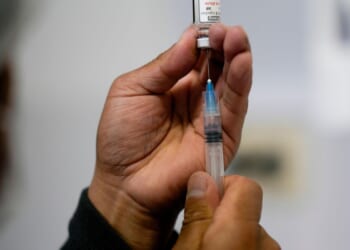Both David and I have been writing about grade inflation and math scores recently. Rather than recapitulate those stories I’ll just let Megan McArdle make the case from her most recent opinion piece for the Washington Post:
There has been a lot of that going on recently, most notably in education. Instead of rectifying disparities in preparation and achievement, people decided it would be simpler to adjust the measurements. Parents opposed standardized testing, got their kids disability diagnoses that allowed them extra time on tests and lobbied teachers to change bad grades. Exhausted teachers responded with grade inflation, which also helped conceal that low-income and minority kids weren’t doing as well as their richer and White peers. Progressive educators watered down curriculums, gutted gifted and talented programs, and weakened admissions standards for honors classes and magnet schools. Colleges dropped standardized testing requirements, in part because that made it easier to diversify their student body. None of these things happened everywhere, but they happened in many places, and all of them made it harder to see — or rectify — pandemic-era learning loss.
The results of this thinking can be seen in a recent report from the University of California at San Diego, which like the rest of the UC system stopped accepting standardized test scores in 2020. In 2024 the school had to redesign its remedial math program to create a class that focused entirely on remediating elementary school and middle school math. In 2025, more than 8 percent of entering students needed that class.
These are college students who chose to enroll in a major with a math requirement yet struggle to round numbers to the nearest hundred, add or divide fractions, or work with negative numbers.
Again, from David’s post, here’s a sample of problems these students headed to college couldn’t do.
UCSD’s “Math 2” course teaches grade-school math (grades 1–8) to freshmen. From page 49 of the university’s own report:
• 25% of students got 7 + 2 = ___ + 6 wrong
• 61% of students, a large majority, couldn’t round 374,518 to the nearest hundred
• 37% of students couldn’t… https://t.co/GGDvrF5AIy pic.twitter.com/2WepqqnmWp— Chris Brunet (@chrisbrunet) November 11, 2025
To be clear, UC San Diego is not an easy school to get into. And yet, a lot of these top students being admitted can’t do Elementary and Middle School math problems. Why is that?
Well, as Megan McArdle suggested this happened because the UC system did away with SAT scores. SATs aren’t just optional in the UC system, they are forbidden. The single person who is probably most responsible for that decision, which was made in 2020, is Saul Geiser. Today, Geiser has a opinion piece of his own for Inside Higher Ed in which he argues that dropping the SAT has been a big success because racial equity has increased.
In one UC study I conducted, all UC applicants were ranked into ten equal tiers by high school GPA. The same students were then ranked by SAT scores and the proportion of Latino and Black students in each tier compared. The difference was dramatic. At the top of the applicant pool— where the chance of admission is greatest—Latinos and Blacks comprised 23 percent of the top GPA tier but only 5 percent of the top SAT tier. Similar differences were found for low-income and first-generation applicants. Far from leveling the playing field, the SAT steepens the climb.
Here’s the chart he’s describing.
It certainly shows that “Latinx and Black” students are a higher percentage of the top 10% when it comes to grades than when it comes to SAT scores. And from this his takeaway is that if we do away with SATs and only look at grades, universities can bring in a lot more minority students.
The SAT was once seen as a tool for democratization, identifying “diamonds in the rough.” Today, it’s more a measure of inherited privilege. Before UC dropped the test, more than 40 percent of the variation in applicants’ SAT scores was explained by family background—income, parental education and race—compared to just 9 percent for GPA. Treating the test as a neutral measure of merit is an illusion.
Public universities know this firsthand. The most able students aren’t always those with the highest test scores but those who’ve proven themselves over years in their schools and communities. These are the students most likely to drive social mobility—the core of the public mission.
Two points about this. First, the percentage of California students who are Black or Hispanic is close to 60% at this point in time. So having only 23% of that majority in the top decile already shows these students are not achieving top grades at anything close to their percentage of the population. Best I can tell, he doesn’t have anything to say about that achievement gap.
The second point is a bit more complicated. Schools and even individual teachers within schools grade classes differently, especially in the wake of the pandemic. Some schools and teachers give out As like candy at this point and do their best not to fail anyone. Other schools and teachers are much more competitive and actually make kids work pretty hard for top grades.
And it’s not just grades that differ. One calculus class might go through 50% of the material in a given year. Another class might get through 90% of the material in that same year. In that case, getting an A in the first class is going to be a breeze compared to getting an A in the second class. In fact, a kid who got a B in a tough class with no curve might actually know the material better than a kid who got an A in an easy class with a teacher who curves every test.
My point here is that grades and expectations from school to school may differ widely, but SAT tests do not. With the SAT, everyone is getting more or less the same test at the same exact time.
So I think what the chart above is showing is that, if you really test students from different schools with one consistent standard (the SAT), you’ll find out that a lot of the kids with top grades at Podunk High can’t get top test scores because they haven’t actually learned that much. (A top 10% test score on the SAT would be 1350 or above).
It could be because they were graded very easily or because the classes didn’t cover the full range of material or both. Whatever the cause, the fact remains that some kids have mastered the material on a statewide and indeed nationwide scale and some have only gotten an A in their high school class from the teacher everyone considers and easy A. Those two things are not at all the same. But Saul Geiser seems more than happy to sidestep all of this so long as the result is greater racial equity.
UC has now been test-free for four years. The sky hasn’t fallen. Academic standards haven’t slipped. What has changed is the student body: More low-income, first-generation and underrepresented students are earning spots without affirmative action.
It sounds great, but we know standards have slipped because 25% of students at UCSD can’t solve got 7 + 2 = ___ + 6 and 61% of students can’t round 374,518 to the nearest hundred. Good grief, man! These are problems students should be able to solve by 5th grade. Academic standards have definitely slipped if incoming college freshman are stumped by these questions.
Editor’s Note: Do you enjoy Hot Air’s conservative reporting that takes on the radical left and woke media? Support our work so that we can continue to bring you the truth.
Join Hot Air VIP and use the promo code FIGHT to get 60% off your VIP membership!










